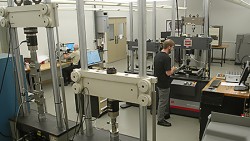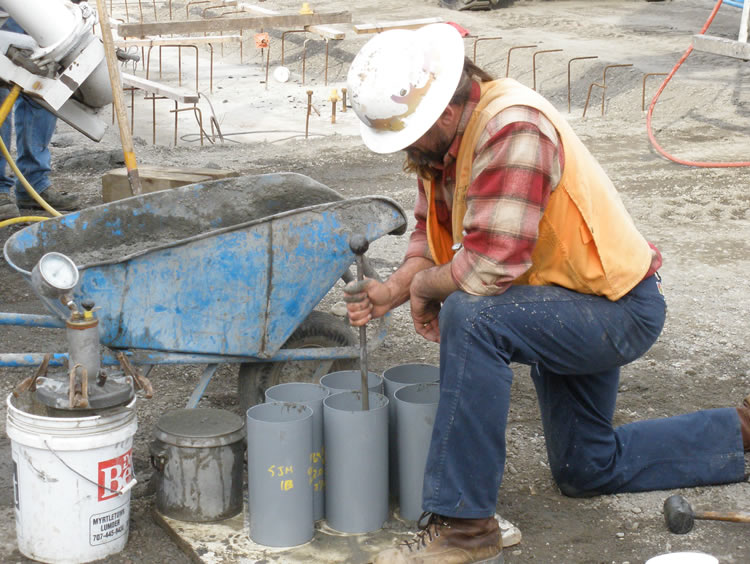Unlocking Precision: Materials Test Lab Excellence Revealed
Wiki Article
From Principle to Truth: The Significance of Products Testing in Product Growth
Worldwide of product growth, the journey from principle to truth is a complex and elaborate process. One essential element that frequently goes unnoticed but plays an essential function is products testing. Products testing is the organized evaluation and analysis of the buildings and behavior of different materials utilized in item development. It entails defining material needs, conducting toughness and resilience screening, assessing chemical make-up and compatibility, and assessing safety and security and performance requirements. By subjecting products to extensive screening, product designers can make best use of item top quality, dependability, and eventually, customer fulfillment. This article checks out the relevance of materials testing in item development and highlights its importance in transforming innovative ideas right into substantial, successful products.Defining Material Requirements

To specify product needs properly, comprehensive research study and analysis are needed. The item growth group have to consider factors such as mechanical homes, chemical resilience, compatibility, and cost-effectiveness. They need to additionally consider any kind of governing or safety and security requirements that the product needs to fulfill.
Among the vital purposes in defining product needs is to determine materials that can endure the anticipated tensions and strains the item will certainly experience during its lifecycle. This includes taking into consideration aspects such as temperature fluctuations, direct exposure to dampness or chemicals, and mechanical forces. By selecting products that can stand up to these conditions, the product's efficiency and durability can be optimized.
In addition, specifying material needs likewise involves taking into consideration the aesthetic and tactile top qualities of the materials. The aesthetic charm, texture, and really feel of the product play a significant function in its marketability and customer experience.
Carrying Out Strength and Longevity Checking
To guarantee the integrity and durability of an item, carrying out toughness and sturdiness testing is necessary in the product growth process. This kind of screening enables suppliers to comprehend just how a product will certainly perform under different problems and tension degrees, helping them make notified choices about layout modifications and material choices.Stamina screening involves subjecting an item to regulated forces to identify its capacity to endure tons and stress. This can be done through tests such as stress, compression, flexing, and torsion tests. By measuring the item's feedback to these forces, engineers can examine its architectural integrity and determine any type of weak points or possible failure points.

Examining Chemical Composition and Compatibility
Chemical structure and compatibility analysis is a vital action in the product growth process as it allows makers to assess the suitability of products for their intended applications. Comprehending the chemical make-up of a product is important to guarantee that it satisfies the necessary demands for performance, security, and capability.Throughout the assessment process, makers assess the chemical composition of materials to identify their buildings, such as strength, resilience, and resistance to rust. This info assists in choosing the most appropriate materials for specific applications, as different products might have differing chemical structures that impact their performance.
Compatibility assessment is equally important, as it ensures that the products made use of in an item work with each other and with any various other materials they might come into contact with. Conflict can bring about chain reactions, deterioration, or even failure of the item.
To examine chemical compatibility, producers conduct examinations to assess and imitate real-world conditions how different products engage. These examinations may consist of direct exposure to numerous temperatures, pressures, and chemicals. The outcomes of these tests aid makers determine any possible concerns and make notified choices about product choice and design alterations.
Assessing Security and Performance Requirements
Manufacturers have to extensively analyze safety and security and efficiency requirements to guarantee the quality and reliability of their items. Efficiency standards, on the various other hand, emphasis on examining the product's ability to fulfill certain performance criteria and specifications. By analyzing security and performance criteria, makers can determine any possible problems or shortcomings in their items and take the needed steps to resolve them.
Optimizing Item High Quality and Dependability
By making sure the complete evaluation of security and performance standards, suppliers can properly maximize the top quality and integrity of their products. Taking full advantage of product quality and integrity is vital for services to acquire an one-upmanship and maintain consumer satisfaction - materials test lab. To attain this, manufacturers must use strenuous screening methods throughout the item advancement procedureOne important facet of making best Check Out Your URL use of product quality and integrity is carrying out thorough materials testing. This entails examining the homes and characteristics of the products used in the manufacturing of the item. By checking the products for elements such as durability, stamina, and resistance to ecological basics problems, manufacturers can determine possible weaknesses and make required renovations to enhance the overall high quality and integrity of the product.
Furthermore, makers should also think about making use of advanced testing methods, such as non-destructive testing (NDT) NDT permits the evaluation of a product's stability without triggering damages, making certain that the quality and reliability of the product are not jeopardized throughout the screening procedure.
In addition, manufacturers should continuously keep track of and examine the efficiency of their items in real-world problems. This can be done via field screening and gathering comments from consumers. By accumulating and examining data on item performance, manufacturers can identify locations for enhancement and make needed changes to improve the quality and integrity of their products.
Final Thought
In conclusion, materials testing plays an important function in product development by ensuring that the products utilized meet the essential needs for stamina, sturdiness, chemical structure, compatibility, security, and performance criteria. By carrying out comprehensive testing, suppliers can make best use of the high quality and reliability of their items - materials test lab. It is vital to focus on products evaluating throughout the advancement process to make certain the successful realization of principles right into substantial productsProducts testing is the systematic assessment and analysis of the buildings and habits of numerous products utilized in item advancement. By subjecting products to extensive screening, product designers can make the most of item quality, integrity, and eventually, client fulfillment.One of the crucial purposes in specifying product demands is to identify materials that can endure the awaited stresses and strains the product will certainly experience during its lifecycle. By collecting and evaluating data original site on product efficiency, manufacturers can recognize areas for enhancement and make needed modifications to boost the high quality and integrity of their items.
In final thought, products testing plays a critical role in item advancement by ensuring that the materials used satisfy the needed needs for stamina, resilience, chemical make-up, efficiency, safety and security, and compatibility criteria.
Report this wiki page